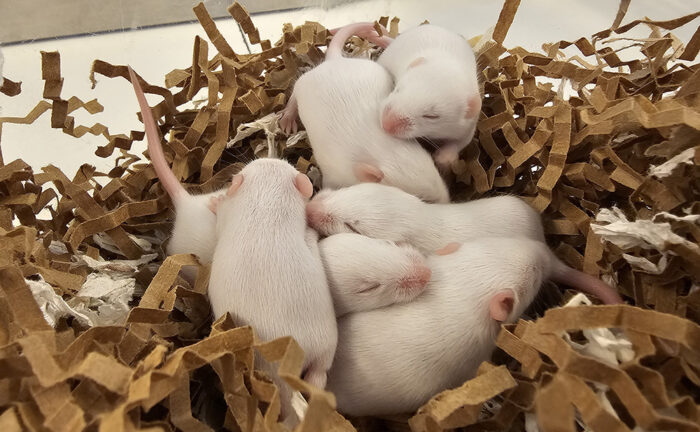Introduction of ultrasound machines allows animal technicians to accurately determine early pregnancy in mice, reducing numbers needed for research

Several research groups across the LMB require early-stage mouse embryos to aid their investigation into a wide variety of topics. This includes studying mammalian embryonic development to ascertain how complex, three-dimensional organs form, and what factors can lead to developmental problems. On average, the gestation period for mice is 20 days, meaning that the difference of just one day can drastically alter embryos which impacts their research utility. Therefore, it is hugely important for animal technicians to be able to accurately detect pregnancy as early as possible. Traditionally, this has been done using a combination of visual checks and palpating the abdomen. These methods are subjective and can lack accuracy and, crucially, are most reliable from 12.5 days onwards (though experienced technicians may be able to use palpation from 9.5 days). Spearheaded by technicians Kirsty Kemp and Carolyn Karam, the LMB’s Biological Services Unit has introduced ultrasound machines, which are capable of earlier, more accurate pregnancy confirmations and ultimately reduces and refines animal usage.
The introduction of the ultrasound machine at the LMB’s Biological Services Unit was brought about by a research requirement in 2017 for early time point embryos at 8.5 days – too early to reliably use abdomen palpations to confirm pregnancy. In 2022, a new research project required embryos at 5.5 days, further underpinning the need for early pregnancy detection.
It was initially suggested that mice would need to be anaesthetised and shaved in order to get accurate readings. However, Kirsty and Carolyn refined this process, and found imaging success by gently holding the mice in place, applying 70% ethanol to the stomach and smoothing down fur to remove any air bubbles which could distort the reading. Ultrasound gel was then applied to the abdomen, to help conduct the sound waves. Two main types of scans are carried out; pelvis scans where the probe is held horizontally, and spinal scans where the probe is positioned vertically.
On average, it takes just 50 seconds to collect ultrasound images of mice
On average, the time taken to ultrasound the mice is just 50 seconds. Owing to this short process, coupled with the fact that the mice have no need for anaesthetisation, the mice quickly return to their cages and exhibit no signs of distress or behavioural changes. The entire procedure is classified as ‘subthreshold’ according to severity regulations under the Animal Scientific Procedures Act (ASPA), meaning it has little to no impact on the animals’ welfare. Additionally, all LMB mice are handled with a cupped hand or within a cardboard tube – rather than by the tail – which further reduces the possibility for causing undue stress during scanning.
When mice are required at a very specific gestation point, LMB technicians can arrange timed matings. Mice typically mate during the night, and gestation is measured beginning at 0.5 days the following morning. Technicians use visual checks to determine if female mice have entered the correct stage of oestrus or ‘heat’. This can be encouraged by exposing the female to a small amount of male bedding for a day or two, the scent of which triggers her to come into oestrus. Once established, the two mice can be introduced to each other and will likely mate that night. Pregnancy can later be confirmed by ultrasound, and technicians can accurately confirm the gestation period by referring to the timed mating.
At around 9.5 days of gestation it is possible to detect a heart beat
The introduction of ultrasounds at the LMB’s Biological Services Unit has drastically increased accuracy in pregnancy determination, with no detrimental effects to the animals. In measuring embryos at 5.5 – 6.5 days, ultrasounds were used to gain correct readings 85% of the time, and at 7.5 – 12.5 days this figure increased to 91%. Aside from the benefits in detecting pregnancies earlier, the technique is also crucially more accurate at determining when mice are not pregnant. These mice can then attempt breeding again, rather than starting from scratch with a new pair, meaning there is an overall reduction in the number of mice required. Overall, this is a 35% increase in accuracy on previous pregnancy detection methods. It is expected that accuracy rates will continue to rise, and the facility has introduced a successful in-house training programme to teach more technicians the ultrasound process. In reducing the number of mice needed and refining the procedures undertaken by the mice, this endeavour has significantly addressed two of the 3Rs which underpin all animal use at the LMB.
Kirsty presented details of this work at an Institute of Animal Technology (IAT) meeting in 2018, for which she was awarded first place in the Steve Moore Memorial Prize.
This work was funded by UKRI MRC.
Further references
Ultrasound to ultrasee – the use of ultrasound to determine pregnancy in mice. Karam, C. and Kemp. K. IAT Animal Technology and Welfare
Animal Research at the LMB
Championing non-aversive mouse handling